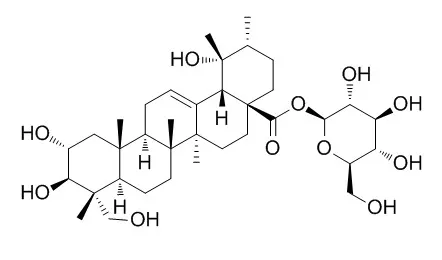| Description: |
Niga-ichigoside F1(NI) has anti-inflammatory, gastroprotective ,antinociceptive, and cytotoxic effects. NI showed an inhibition zone on β-glucosidase and anti-acetylcholinesterase assays. The dietary NI could prevent HFD-induced hepatic steatosis, possibly via interacting with HFD to activate Nrf2 nuclear translocation to maintain a redox status, thus regulating lipid metabolism genes expressions.
|
| Targets: |
Nrf2 | NO | SOD | GPx | CAT |
| In vitro: |
| Nat Prod Res. 2017 Jun;31(11):1333-1338. | | Biological activities of triterpenoids from Poraqueiba sericea stems.[Pubmed: 27736194 ] | Eleven compounds were isolated from Poraqueiba sericea stems and identified as Niga-ichigoside F1 (1), trachelosperoside B1 (2), 4-epi-niga-ichigoside (7), 19α-hydroxyasiatic acid (3), myrianthic acid (4), hyptatic acid (5), trachelosperogenin B (6), arjunolic acid (8), and trachelosperogenin E (9), secologanoside (10) and secoxyloganin (11).
METHODS AND RESULTS:
Compounds 1-11 were tested for their antileishmanial activities against Leishmania infantum promastigotes, 1-6 and 8-11 were tested for their cytotoxic activities on fibroblasts, 1-3, 5-6, 8-11 were evaluated for their anti-elastase and anti-acetylcholinesterase assays activities by a spectrophotometric method and 1-2, 5 and 7-10 were tested using bioautography for their β-glucosidase.
CONCLUSIONS:
No antileishmanial activity was detected; compounds 1, 2 and 11 showed a moderate cytotoxic activity with IC50 17.7, 20.5 and 10.9 μg/mL, respectively; compounds 2, 8, 9 and 10 gave a percentage of inhibition ranging from 13 to 16% (at 50 μg/mL) and compounds 1 and 2 showed an inhibition zone on β-glucosidase and anti-acetylcholinesterase assays. | | Naunyn Schmiedebergs Arch Pharmacol. 2016 Nov;389(11):1235-1244. | | Rubus imperialis (Rosaceae) extract and pure compound niga-ichigoside F1: wound healing and anti-inflammatory effects.[Pubmed: 27527496 ] | Here, we evaluate the anti-inflammatory and wound-healing effects of methanolic crude extract obtained from aerial parts (leaves and branches) of Rubus imperialis Chum. Schl. (Rosaceae) and the pure compound Niga-ichigoside F1.
METHODS AND RESULTS:
Anti-inflammatory activity was determined in vivo and in vitro, and the healing effect was evaluated in surgical lesions in mice skin. The 1,1-diphenyl-2-picrylhydrazyl radical (DPPH) assay and H2O2-induced oxidative stress were used to determine antioxidant activity. The efferocytosis activity was also determined. The data obtained show that the extract of R. imperialis promote reduction in the inflammatory process induced by lipopolysaccharide (LPS) or carrageenan in the air pouch model; the effects could be reinforced by nitric oxide reduction in LPS-stimulated neutrophils, and an increase in the efferocytosis. The extract showed wound healing property in vitro and in vivo, scavenging activity for DPPH, and cytoprotection in the H2O2-induced oxidative stress in L929 cells. In addition, the compound Niga-ichigoside F1 was able to reduce the NO secretion; however, it did not present wound-healing activity in vitro.
CONCLUSIONS:
Together, the data obtained point out the modulatory actions of R. imperialis extract on leukocyte migration to the inflamed tissue, the antioxidant, and the pro-resolutive activity. However, the R. imperialis anti-inflammatory activity may be mediated in parts by Niga-ichigoside F1, and on wound healing do not correlated with Niga-ichigoside F1. |
|
| In vivo: |
| Naunyn Schmiedebergs Arch Pharmacol. 2014 Apr;387(4):313-9. | | Evaluation of the gastroprotective activity of the extracts, fractions, and pure compounds obtained from aerial parts of Rubus imperialis in different experimental models.[Pubmed: 24402081 ] | Previous phytochemical studies carried out with Rubus imperialis Chum. Schl. (Rosaceae) have demonstrated the presence of triterpenes (Niga-ichigoside F1 and 2β,3β,19α-trihydroxyursolic acid) in this species. The literature indicates that triterpenes are closely related to some pharmacological activities, including antiulcer activity. Therefore, in view of the previous promising results with this species, this work extends the phytochemical studies, as well as investigates its gastroprotective action in different models using rodents.
METHODS AND RESULTS:
The hydroalcoholic extract was tested using the following protocols in mice: ethanol/HCl and nonsteroidal anti-inflammatory drug (NSAID)-induced ulcer, acetic acid-induced chronic ulcer, ligature pylorus model, and free mucus quantification in mucosa. Isolated triterpenes were investigated in the ethanol/HCl-induced ulcer model. The results of this study show that R. imperialis extract (100, 250, or 500 mg) displays gastroprotective activity in the ethanol-induced ulcer model with a percentage of inhibition of gastric lesions of 70, 71, and 86 %, respectively. The extract also significantly reduced the ulcerative lesions in the indomethacin-induced ulcer. In this model, the percentage of inhibition of ulcer was 41, 44, and 70 %, respectively. Regarding the model of gastric secretion, a reduction of gastric juice volume and total acidity was observed, as well as an increase in gastric pH; however, gastric mucus production was not altered by treatment with the extract. It was also observed that the ethyl acetate fraction presented higher activity, leading to the isolation of Niga-ichigoside F1 and 2β,3β-19-α-trihydroxyursolic acid, which presented antiulcer activity comparable to that of omeprazole, with an inhibition percentage of 98 and 99 %, respectively.
CONCLUSIONS:
These results demonstrate that R. imperialis extract and isolated compounds (Niga-ichigoside F1 and 2β,3β-19-α-trihydroxyursolic acid) produce gastroprotective effects, and this activity seems, at least in part, to be related to antisecretory effects. |
|






 Cell. 2018 Jan 11;172(1-2):249-261.e12. doi: 10.1016/j.cell.2017.12.019.IF=36.216(2019)
Cell. 2018 Jan 11;172(1-2):249-261.e12. doi: 10.1016/j.cell.2017.12.019.IF=36.216(2019) Cell Metab. 2020 Mar 3;31(3):534-548.e5. doi: 10.1016/j.cmet.2020.01.002.IF=22.415(2019)
Cell Metab. 2020 Mar 3;31(3):534-548.e5. doi: 10.1016/j.cmet.2020.01.002.IF=22.415(2019) Mol Cell. 2017 Nov 16;68(4):673-685.e6. doi: 10.1016/j.molcel.2017.10.022.IF=14.548(2019)
Mol Cell. 2017 Nov 16;68(4):673-685.e6. doi: 10.1016/j.molcel.2017.10.022.IF=14.548(2019)